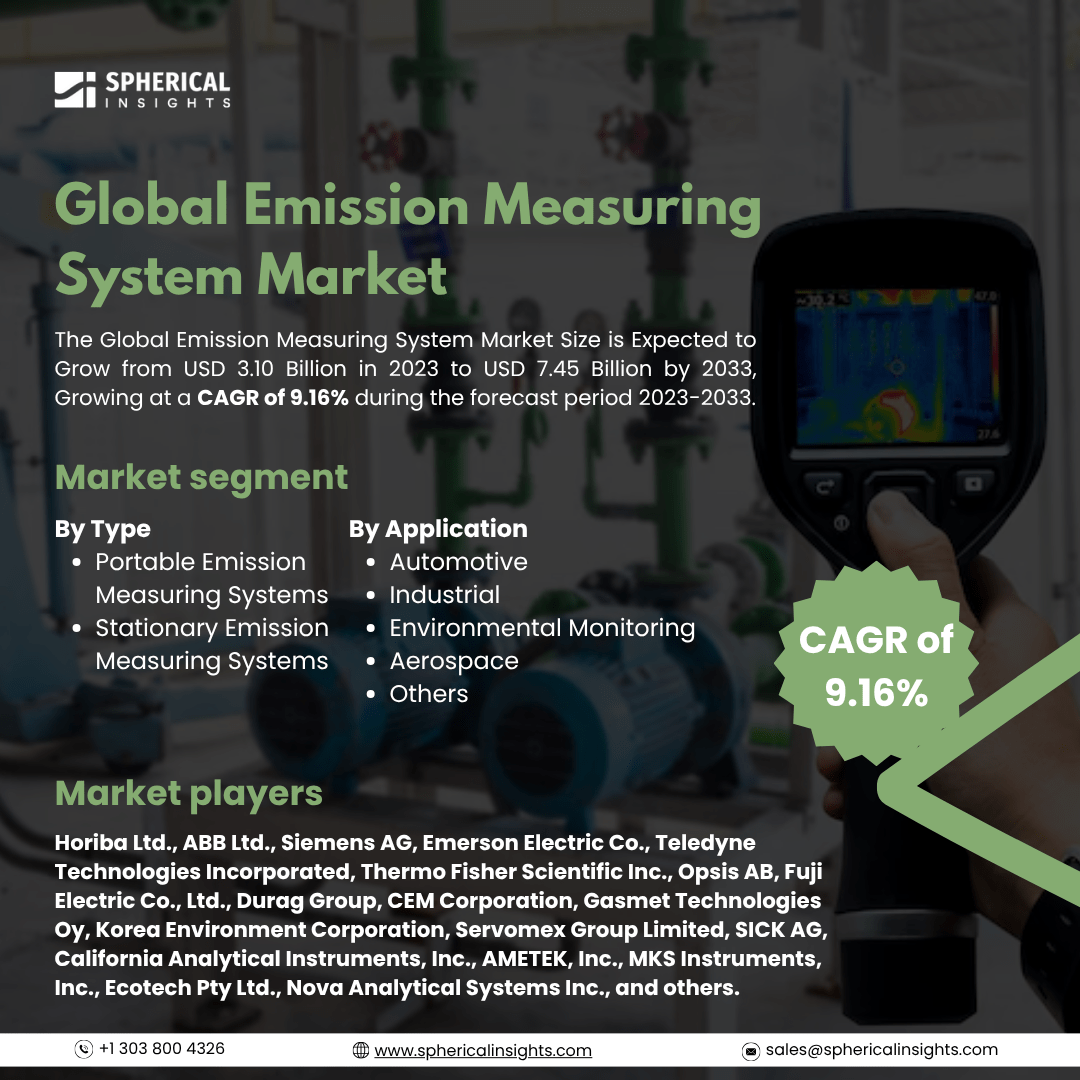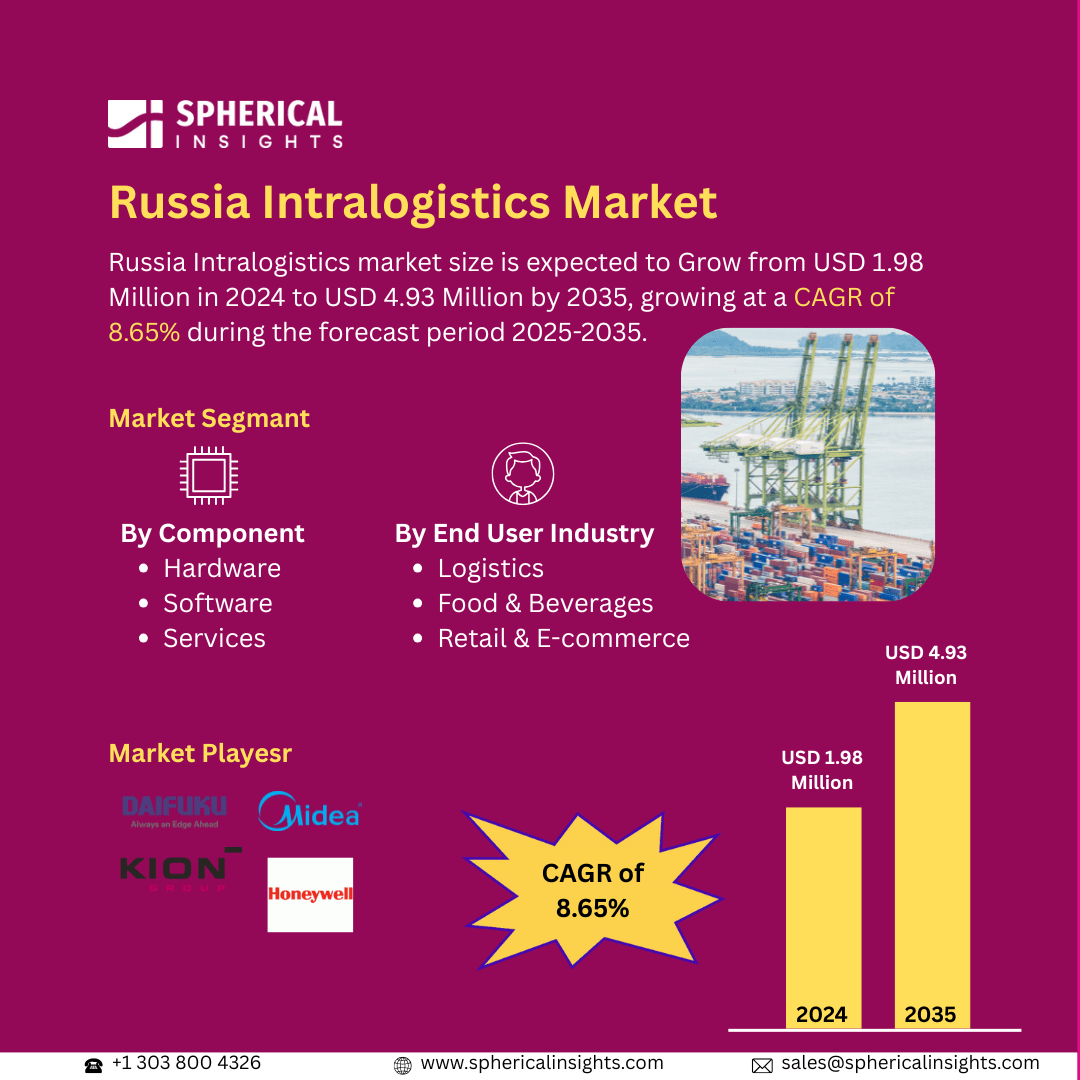Global Emission Measuring System Market Size To Exceed USD 7.45 Billion By 2033
According to a research report published by Spherical Insights & Consulting, The Global Emission Measuring System Market Size is Expected to Grow from USD 3.10 Billion in 2023 to USD 7.45 Billion by 2033, Growing at a CAGR of 9.16% during the forecast period 2023-2033.
Browse 210 market data Tables and 45 Figures spread through 190 Pages and in-depth TOC on The Global Emission Measuring System Market Size, Share, and COVID-19 Impact Analysis, By Type (Portable Emission Measuring Systems, Stationary Emission Measuring Systems), By Application (Automotive, Industrial, Environmental Monitoring, Aerospace, and Others), and By Region (North America, Europe, Asia-Pacific, Latin America, Middle East, and Africa), Analysis and Forecast 2023 - 2033
The global emission measuring system (EMS) market refers to the sector focused on technologies and solutions designed to monitor and measure emissions from various industrial sectors such as manufacturing facilities, power plants, and the automotive sector. These systems help regulatory bodies comply with environmental norms by tracking pollutants such as carbon dioxide, sulfur dioxide, nitrogen oxides (NOX), and particulate pollutants. The market growth is driven by stringent environmental regulations, advancements in Sensor technologies, and the growing emphasis on sustainable industrial practices. Further, the market is expanding due in significant measure to technological developments in Emission measuring devices. Like, these systems integrated with AI and Big Data yield actionable insights, giving end users a competitive advantage. Moreover, the strict emission rules enforced by various governments worldwide are one of the most important reasons for the market expansion. However, the high cost of deployment and highly need to maintain it periodically with skilled personnel might limit their growing pace.
The stationary emission measuring systems segment held the highest share of the global emission measuring system market in 2023 and is predicted to grow at a remarkable CAGR over the forecast period.
On the basis of the type, the global emission measuring system market is divided into portable emission measuring systems, and stationary emission measuring systems. Among these, the stationary emission measuring systems segment held the highest share of the global emission measuring system market in 2023 and is predicted to grow at a remarkable CAGR over the forecast period. This segment growth is driven because of monitoring and surveillance data of pollution levels, and it becomes an ideal choice for a large-scale industrial facility.
The industrial segment accounted for the highest share of the global emission measuring system market in 2023 and is expected to grow at a substantial CAGR over the forecast period.
On the basis of the application, the global emission measuring system market is segmented into automotive, industrial, environmental monitoring, aerospace, and others. Among these, the industrial segment accounted for the highest share of the global emission measuring system market in 2023 and is expected to grow at a substantial CAGR over the forecast period. This is due to for monitoring and managing emissions from factories, refineries, and power plants.
Asia Pacific is anticipated to hold the highest share of the global emission measuring system market over the forecast period.
Asia Pacific is expected to hold the highest share of the global emission measuring system market over the forecast period. The regional market growth is influenced by organizations investing in cutting-edge emission monitoring systems to comply with the strict emission restrictions that governments are enforcing to combat air pollution. In this region, the need for emission measuring systems is being driven by the fast industrialization and urbanization of nations like China and India.
North America is estimated to grow at the fastest CAGR of the global emission measuring system market over the forecast period. The regional market growth is accelerated because of its strict environmental standards and the implementation of best practices for emission control. Further, the demand for sophisticated emission monitoring systems is being driven by the strict emission requirements of the US and Canada, and the presence of significant industry players and ongoing technical developments.
Company Profiling
Major vendors in the global emission measuring system market are Horiba Ltd., ABB Ltd., Siemens AG, Emerson Electric Co., Teledyne Technologies Incorporated, Thermo Fisher Scientific Inc., Opsis AB, Fuji Electric Co., Ltd., Durag Group, CEM Corporation, Gasmet Technologies Oy, Korea Environment Corporation, Servomex Group Limited, SICK AG, California Analytical Instruments, Inc., AMETEK, Inc., MKS Instruments, Inc., Ecotech Pty Ltd., Nova Analytical Systems Inc., and others.
Key Target Audience
- Market Players
- Investors
- End-users
- Government Authorities
- Consulting And Research Firm
- Venture capitalists
- Value-Added Resellers (VARs)
Recent Development
- In March 2025, HORIBA unveiled the MEXAcube, a compact emissions measurement system designed for high-precision exhaust gas analysis in both laboratory and real-world conditions. Further, by applying this single gadget, nine emission components were measured with high accuracy in both lab and real-world tests.
Market Segment
This study forecasts revenue at global, regional, and country levels from 2023 to 2033. Spherical Insights has segmented the global emission measuring system market based on the below-mentioned segments:
Global Emission Measuring System Market, By Type
- Portable Emission Measuring Systems
- Stationary Emission Measuring Systems
Global Emission Measuring System Market, By Application
- Automotive
- Industrial
- Environmental Monitoring
- Aerospace
- Others
Global Emission Measuring System Market, By Regional
- North America
- Europe
- Germany
- UK
- France
- Italy
- Spain
- Russia
- Rest of Europe
- Asia Pacific
- China
- Japan
- India
- South Korea
- Australia
- Rest of Asia Pacific
- South America
- Brazil
- Argentina
- Rest of South America
- Middle East & Africa
- UAE
- Saudi Arabia
- Qatar
- South Africa
- Rest of the Middle East & Africa



